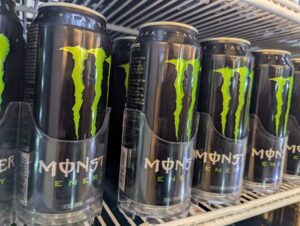On campus, energy drinks are abundant. Cans of Rockstar and Monster line lecture halls and fill recycling bins. Yet, energy drinks are perhaps not as innocuous as one might assume. What even are energy drinks? Are they truly safe to consume?
The most important component of energy drinks to question is arguably the most regulated: caffeine. Every energy drink on campus contains, by its nature, supplemented caffeine and a warning not to consume more than a certain amount of the product per day—often, the number is one or two cans.
Canadian Beverage Association communications and engagement specialist Ana Hamilton says the labelling is part of regulations for food packaging to keep people safe.

“Under the Supplemented Foods Regulations, energy drinks providing more than 79 mg caffeine per serving must provide a statement indicating the maximum number of servings of the product that can be consumed daily to not exceed the daily limit for adults set by Health Canada of 400 mg of caffeine,” she says.
Hamilton stresses that one benefit to energy drink consumption over more traditional means like coffee is that consumers are better able to monitor caffeine intake.
“One benefit of energy drinks over coffee is that, due to the caffeine source, producers of energy drinks know and advertise the exact amount of caffeine in your beverage,” she says. “This is because coffee contains naturally occurring caffeine, which can vary in amount depending on processing, whereas energy drinks contain added caffeine in known and consistent amounts. The structural and physiological properties between the two caffeine sources are identical.”
Of course, all of the energy drinks on campus, apart from Yerba Mate (if it can indeed be called an energy drink), contain supplements other than caffeine. In practice, the typical energy drink on campus is a combination of vitamins (usually, B vitamins), and caffeine and other legal stimulants such as guarana and taurine. Questions regarding the health effects of drinks such as Red Bull, Rockstar, and Monster are examined in The Dark Side of Energy Drinks: A Comprehensive Review of Their Impact on the Human Body by Andrea Constantino, et al., published in the National Library of Medicine.
“Reports underscore that energy drinks have deleterious effects on a broad spectrum of bodily organs,” a section of the report concludes, “culminating in mild adversities such as anxiety, gastrointestinal disturbances, dehydration, nervousness, and tachycardia, along with more severe outcomes like rhabdomyolysis, acute kidney injury (AKI), ventricular fibrillation, seizures, acute mania, and stroke.”
The paper stresses that while individual ingredients are shown to be safe, excessive energy drink consumption often leads to adverse health effects. To mitigate these dangers, the paper urges caution.
“We suggest that the daily intake of energy drinks should not only not exceed the safety limits for caffeine established by European and American regulatory authorities, but should be even lower,” the report reads. “Indeed, these drinks also contain other neurostimulants, the effects of which are not fully understood. Furthermore, as this review points out, there are cases in the literature of people with no known medical conditions who have suffered acute cardiac events after consuming just a few 250 mL cans of these drinks.”
Students, especially younger persons whose brains are still developing, should be vigilant on their consumption of these drinks. The effects could be catastrophic.
